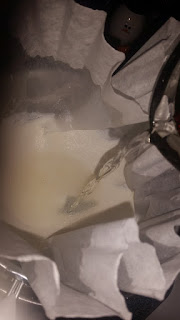Welcome back! Did everyone read this article:
?
In particular, I was fascinated by the assertion that you could use cold milk, as well as letting the punch rest a longer amount of time before straining. That could make creating milk punch at home a much less labour-intensive process, more akin to making bread (one of my favorite home projects) where you work for a short time, let your product rest, and then return to it a couple times. I decided to do a proof of concept, using some infused liquor I had lying around.
A couple years ago, before I moved to my current apartment, I put a bunch of spices and peels in a jar containing the bottom of a couple bootles of liquor so it would all be easy to move and I could use it for a punch base (among other things, it contained dried pimento, cassia cinnamon chips, orange and lemon peel, Rittenhouse Rye, and St. Remy). During the process of moving I forgot about it for a couple weeks and then the end result was so intense that it was pretty undrinkable. I put it aside in case I put together some weird punch or something where it could work, but knew my weird jar would be unreplicable.
Now, though, since I mostly just want to test my new milk-punch process, it’s a perfect guinea pig, since I don’t mind if it goes wrong. And who knows, I might be able to make something drinkable out of it?
Using my trusty notebook of my old recipes, I went through and figured out the ratios of all my old punches. They varied, but most of them stayed pretty close to this ratio:
4 parts strong
4 parts weak
1 part sour
1 part sweet
2 parts milk
So, usually pretty close to the classic 4 strong/6 weak/1 sour/ 1 sweet recipe. The strong were my base spirits and modifiers; I tend to use at proof or overproof spirits as a base, as they infuse flavors a bit better if I’m adding citrus or fruit to them, and helps shore up the abv when adding modifiers. For example, my next recipe will include both standard 40 percent ABV Havana Club, a 136 proof rum agricole, and a port. Barrel-aged spirits contain polyphenolic elements, which can further help the milk curdle, but they will lose some of those flavor elements in the clarifying process
Weak is mostly water (i boil water in a kettle in advance and then let it sit to room temperature, or use water that has been filtered and sits out to get rid of the flouride; I might get distilled water in the future), but I often like using tea to add a nice subtle flavor element, and once again the tannins seem to help with curdling. Green tea or english black teas make a nice starting point, but you can add even stronger, more flavorful teas to add some interesting character. This month, since I’m focusing on simple processes my first month, I’ll be using teas to add character rather than infusing my spirits with spices, herbs, and/or fruit.
The sour is typically citrus. For less acidic citruses, I add a bit more. I’ll play with other acidic sources in February and if successful use them in future punches.
Finally, the sweet. I like making oleo-saccrum rather than just throwing sugar in, because it’s the classic punch thing to do. Oleo saccrum I’ll talk about more in the future, but basically it’s the oil of a citrus peel extracted via osmosis into sugar. I’ll try using different sweeteners, but a base idea for oleo-saccrum is:
Peel the skin off 4 lemons or 3 oranges (or around 3 grapefruit). Make sure there is no pith.
Muddle into 4oz sugar by weight. Seal in an airtight bag or container and let sit until sugar is clear with oil.
You can add the juice of the citrus back to the new oleo and it is a “sherbet”. Alternatively, add some of the water you are using for the punch for easy extraction of the remainder of the peels. I use cheesecloth on the peels to get every last bit of saccrum out.
So, my first recipe was:
2 cups mystery brown liquor infusion
2 cups water
4oz lemon oleo-saccrum
4oz lemon juice
1 cup milk.
Combine ingredients of the punch base, then put milk in large bowl. Add punch base TO the milk, then cover and place in fridge overnight. The next day, pour through a fine mesh strainer (one you can use for pasta, like you get a kitchen supply or dollar store) lined with a large coffee filter over a clean pot. After all the liquid is filtered through once, pour it *slowly* (as to not jostle the collected curds too much) through the curd-holding filters again to further clarify the mixture.
Doing this was a quick and easy process -- it took me less than an hour of actual paying-attention work, and could easily be done without adding a lot more time for two to four times the ingredients. More than that would take a bit more time just in the pouring and filtering step, but not much beyond that.
And low and behold, here’s the result:
Flavor-wise, it went from an undrinkably harsh collection of spices to a weird amari variant with a creamy mouthfeel. A pretty great result for just a proof of concept. As you can see, a lot of the color was stripped out. For reference, here’s the color of Rittenhouse (the mixture was actually daker than this):



























